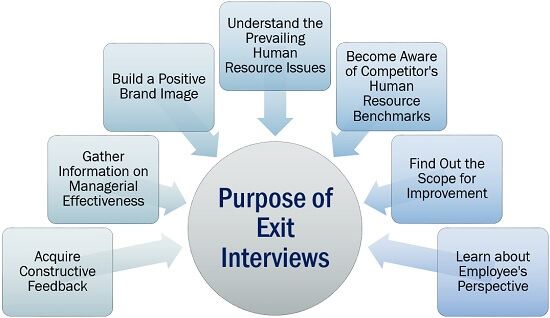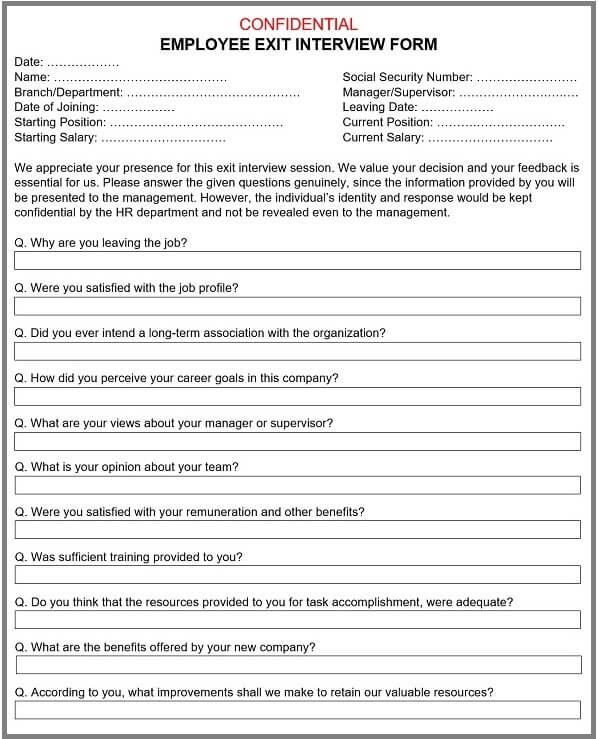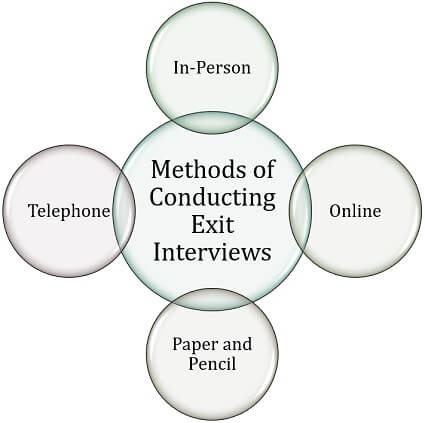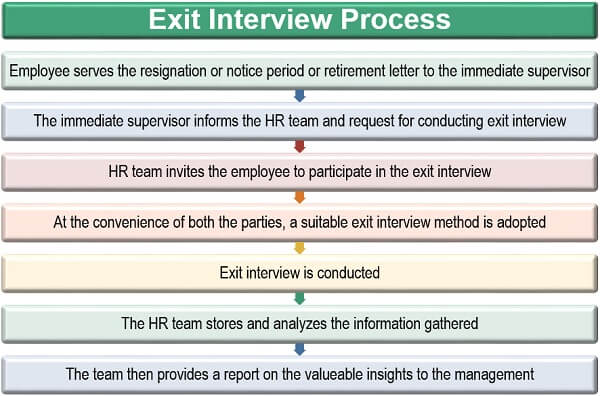Definition: Exit interview is a human resource practice carried out by the organization to gain valuable feedback from the employee who is leaving the organization. It is a standard procedure to obtain insights on the company’s strengths and weaknesses, as perceived by the leaving employee.
In an exit interview, an interviewer can be an HR representative, manager, owner or any other person like a third-party consultant. An interviewee is a person who is terminating his/her services in the organization.
Content: Exit Interview
Purpose of Exit Interviews
For companies, time is equivalent to money. Then why do they invest their ample time in carrying out exit interviews?
This is because such practice can set human resource benchmarks for the companies in the following ways:
- Acquire Constructive Feedback: Exit interview is essential to know the unseen strengths and weaknesses of the company from the employee’s perspective.
- Gather Information on Managerial Effectiveness: It is a useful method for evaluating the manager’s efficiency and leadership skills in the work environment.
- Build a Positive Brand Image: When the employees can share their grievances within the company premises, they feel satisfied and speaks positively in public.
- Understand the Prevailing Human Resource Issues: An exit interview can unfold many pages of the human resource management flaws prevailing in the company.
- Become Aware of Competitor’s Human Resource Benchmarks: If the employee is about to join a competitive firm, the management can get the idea about the human resource standards and practices of the competitor.
- Find Out the Scope for Improvement: The exiting employee can throw light upon the human resource shortcomings which have not been considered by the company yet.
- Learn about Employee’s Perspective: Every personnel has a different opinion about the company, the job, the people and the work environment. Since the employee would convey this impression to the outside world, the company must be aware of it.
Exit Interview Questions
An exit interview is vital for every organization, whether it is a substantial corporate or a small business entity.
Now we are going to discuss some critical EI questions and the insights that each of them provides to the management:
Were you satisfied with the job profile?
This question is merely asked to know if the employee has any role ambiguity or dissatisfaction from the duties assigned to him/her.
Did you ever intend a long-term association with the organization?
It facilitates the management to understand whether the employee was serious about the job or he/she took it up as a temporary or secondary option.
How did you perceive your career goals in this company?
This is to find out about the future expectations and career objectives of the personnel if he/she remained associated with the organization for an extended period.
What is your opinion about your manager or supervisor?
This question can prove to be a landmark to ensure the manager’s efficiency and his/her leadership style.
What is your opinion about your team?
It analyzes the human resource planning abilities in the context of the composition, quality, interpersonal relationship and performance of the group or team, in which the exiting employee was placed.
Were you satisfied with your remuneration and other benefits?
Here, the company can determine if their remuneration system meets employee expectations. Also, if the competitors have a stronger compensation model through which they may attract the company’s top talents.
Was sufficient training provided to you?
This question helps to find out the loopholes in the training and development process of the company.
Do you think that the resources provided to you for task accomplishment were adequate?
The company can take note of any hindrance in production, due to lack of sufficient tools, amenities and resources.
What are the benefits offered by your new company?
If the employee is leaving the job to avail a better opportunity, the company can analyze and compare the additional benefits which the employee’s new company is providing.
According to you, what improvements shall we make to retain our valuable resources?
This is the most valuable information for the company. The exiting employee may enlighten some significant reasons for increasing employee turnover.
Also, it helps in strengthening the organization’s human resource strategies which may have been ignored for an extended period.
Exit Interview Template
Before organizing an exit interview, the management first needs to prepare itself. Some companies even conduct EIs of the involuntarily terminated personnel. The interview questionnaire must be modified according to the termination reason.
The questions should be framed such that they have the potential of seeking maximum information. The sequence of questioning plays a significant role in engaging the employee and acquiring valuable feedback.
Given below is a sample of employee exit form, which has been drafted by considering the above questions:
An exit interview data is highly confidential in terms of an individual’s identity. It should not be formally or informally disclosed among the staff or the management.
Methods of Conducting Exit Interviews
How is an exit interview carried out? What all modes do the interviewer has for it under different circumstances?
Exit interviews usually proceed through personal interaction; however, the company has other means too for such practice. Let us understand the four prominent ways of taking exit interviews:
In-Person: This is a frequently used method of exit interviews where the interviewer engages in a one to one conversation with the interviewee (departing employee).
This type of EI is carried out in the office premises itself. The interviewer has to enter the gathered information in the system physically.
Online: This kind of exit interview is popular in the globally operating companies. The departing employee is asked to take the exit interview on the company’s website.
It provides authentic information and also facilitates automatic data-keeping through the information system.
Paper and Pencil: On the leaving date, the EI form is manually presented or mailed to the leaving employee. It is an elaborated form with multiple questions.
However, many times, employee hesitate in giving an honest review or even avoid submitting the form.
Telephone: A representative from a third party or the HR team reaches out the leaving employee over a phone call to carry out the exit interview.
However, it is an inefficient method due to excessive cost involved in it.
Exit Interview Process
The process of an exit interview varies for every organization. However, the steps discussed below are generally adopted by many companies:
 The exit interview is initiated as soon as the employee serves a notice period or a letter of retirement to his/her respective head.
The exit interview is initiated as soon as the employee serves a notice period or a letter of retirement to his/her respective head.
Next, the supervisor or manager contacts the human resource department to notify the employee’s decision. The HR team confirms the information and then calls the respective personnel for an exit interview.
While many companies go for in-person exit interviews; some may adopt any of the other methods as per the convenience of the interviewer and the interviewee.
Finally, the interview is accomplished, and useful information is stored for further analysis.
After the examination of the data, the HR team compiles the critical information in a report which is late submitted to the senior authorities.
How to make exit interviews useful?
An exit interview can prove to be a milestone in the growth of the organization. Therefore, negative words and questions should be avoided to create an impact on the interviewee.
Also, the interviewer needs to be attentive and responsive in the whole conversation to develop trust and comfort. The points enumerated by the interviewee should be given due consideration while analyzing the information.
The most important of all is that the interviewer should be the person who holds a good reputation among the workers. He/she should be considered reliable and sensible enough so that an effective feedback can be initiated.
Leave a Reply